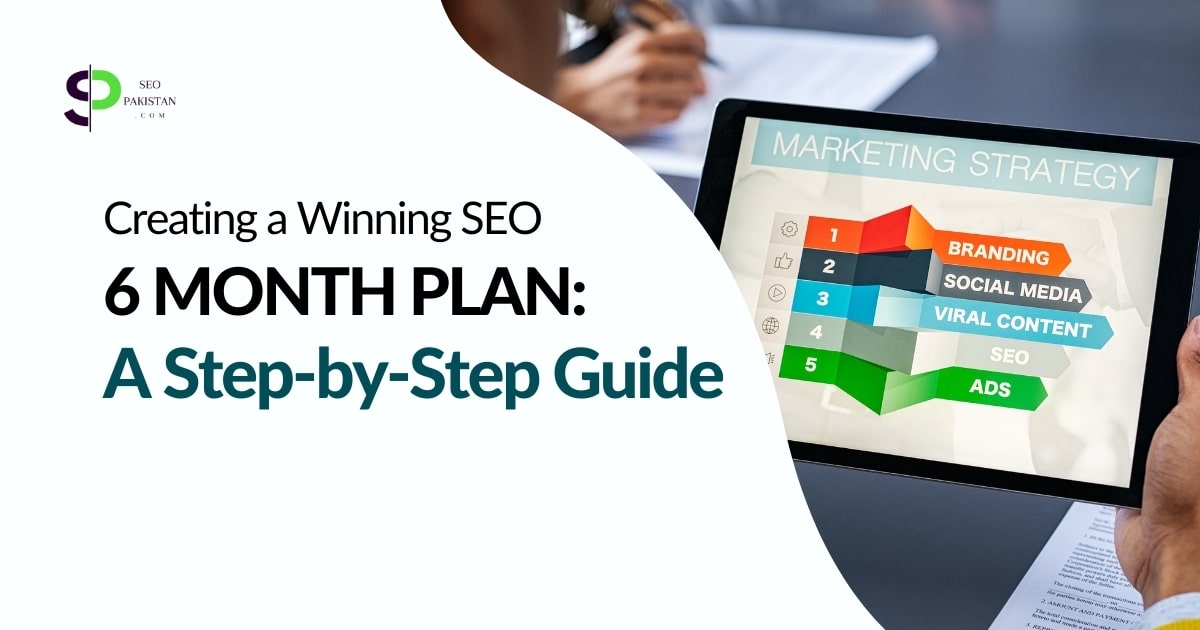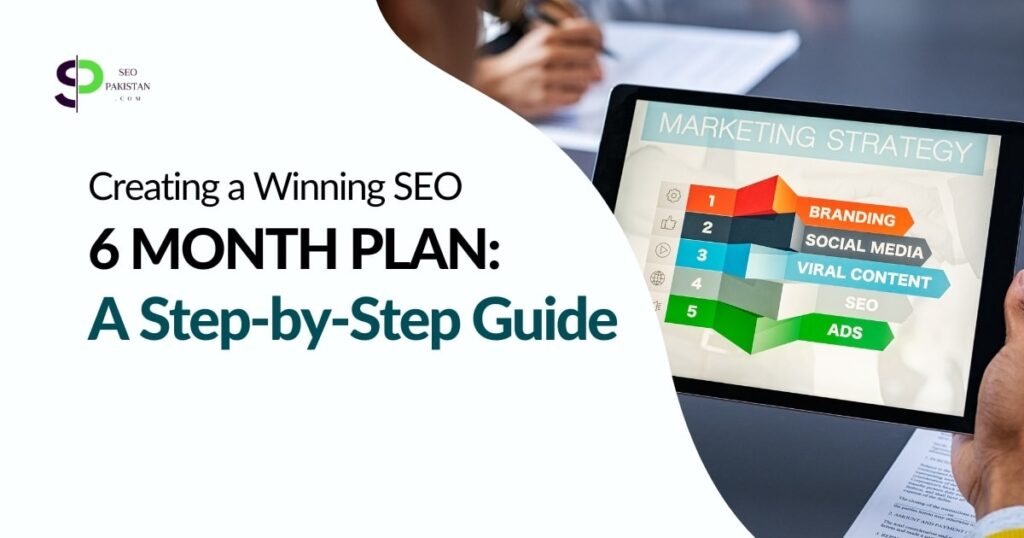
This blog will guide you through each one of them by explaining to you all the tools and information you need in order to start building your SEO strategy that will lead you to victory. This plan can be useful for any person, being an active businessman, marketer or SEO specialist, which will bring stable results and a higher position on the search engine. Let’s get down to business and lay down towards a roadmap of what needs to be achieved in the next six months for SEO.
Table of Contents (Winning SEO 6 Month Plan)
Understanding SEO Planning

What is an SEO Plan?
An SEO plan is an uncompromising prospectus of activities that is carried out with the purpose of bringing traffic to a particular website from search engine results pages. Actually, it covers planning and implementing processes of using specific methods that will allow enhancing the site’s presence in Internet search systems and, therefore, increasing the traffic. The general acception of an SEO plan is having a number of factors to contemplate concerning your website’s substance, web design organization, and general client impression with the view of having optimized SERP rankings.
Businessmen, wishing to succeed in online business, should pay a special attention to the SEO planning stage. Often, an effective approach to get website traffic or blog promotion is not developed, and as a result, it is lost among the number of similar sites and does not attract the target audience. An efficient Search Engine Optimization strategy significantly improves the amount of traffic, while improving its quality by targeting only genuinely interested parties.
Search Engines and SEO Planning
Knowledge of the sector of operations is crucial for SEO strategy preparation, and the sector in question is that of search engines. In general, there are many different search engines but Google’s market share is by far the largest and prominent at 83%. 49% share worldwide. This means that most of the SEO techniques that need to be applied should be friendly with the ‘Googlebots’ and the requirements of the search giant. However, other search engines also contribute to it and should by no means be completely ignored.
- Google: Google being the most used search engine, they act as a standard for using SEO practices. Algorithms are complex, and new modifications occur often, which means it is essential to be knowledgable about the changes.
- Bing: Holding 9.19% of Internet users prefer Bing that belongs to the second tier of the most popular search engines. Still, it is capable of bringing a considerable amount of traffic even though it does not possess the user audience as large as Google’s one, at least not in some specific categories and at some stages of the users’ ages and in some certain regions.
- Others: In addition to Google, other companies also serve the market including Yahoo!, Baidu, YANDEX, and DuckDuckGo. Thus, each network is qualitatively different and caters to a specific audience. For instance, Baidu is dominant in China region while YANDEX in Russia region. Another search engine based on the availability is DuckDuckGo, and it has privacy in its motto, which can attract users who care about their anonymity.
Keyword Research and Strategy Development

Keyword Research: The Foundation of SEO
Keyword research is the building block of any good SEO campaign. It means finding the keywords and phrases that client may use to find similar products or services to yours. It also assist one in developing a clear perception and ways of fulfilling the needs of the audience.
- Identify Goals: Keyword research begins with defining the purpose of a business. A clear comprehension of what is essential to the company as well as how seo can contribute to accomplishing such goals. For instance, if you want to improve the level of sales, target relevant keywords that indicate the readiness to buy a product.
- Conduct Research: Carry out different activities for generating desirable high-frequency keywords related to your specific area of interest. Services such as Google Keywords Planner, Ahrefs, SEMrush, Moz, and others give general data on the key phrase’s popularity and competitors.
- Monitor Performance: Monitor your website’s performance using tools such as Google Search Console on a regular basis. This will assist you in determining the technical problems and which keywords are leading people to your site.
Developing a Keyword-Driven SEO Strategy
After you have a list of keywords, the next step is to create a keyword-focused SEO plan of action. This strategy should therefore involve the creation and optimization of content around these keywords to enhance the search engine ranking and traffic.
- Content Strategy: Create a content plan based on your keyword research. Develop content that will help the users and answer their questions. This can be in the form of blog posts, articles, videos, infographics and any other content that will capture the attention of the audience.
- Keyword Integration: Make sure you use the keywords and phrases that you have identified in your keyword research for your content. It is recommended to use these keywords in the content naturally so that the content is SEO friendly but not at the cost of the user experience.
- Content Calendar: Develop a content plan that includes the topics, formats, and the frequency of the posts for the next six months. This will assist you in keeping track of your posts and guarantee that you are posting fresh content regularly to keep your audience interested and to rank higher on search engines.
On-Page SEO Optimization
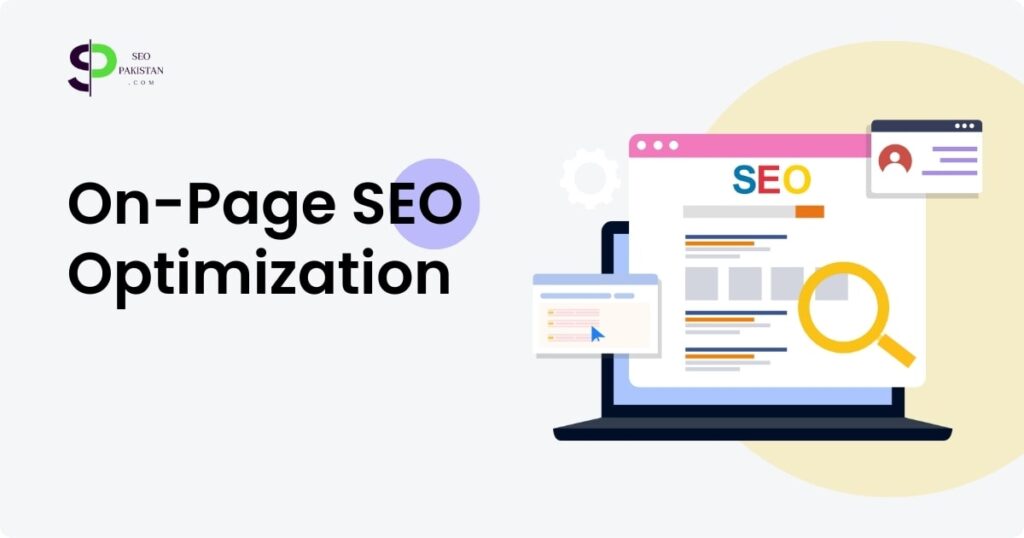
Optimizing Page SEO
On-page SEO is the process of optimizing specific content marketing web pages in order to rank higher in search engines and drive organic traffic. This entails the use of meta titles, meta descriptions, headings, and image alt text based on the keyword research that you conduct.
- Meta Elements: Meta titles, meta descriptions, and headings should also be modified to incorporate the target keywords. This is useful for the search engines to know what your pages are about and increases the likelihood of them ranking higher in the search results.
- Site Performance: Optimize your website for speed, mobile, and usability. A fast, mobile-friendly website is more user-friendly and can help improve your search engine ranking.
- High-Quality Content: Develop relevant, well-written content that focuses on the selected keywords and user intent. Make sure that the content you create is useful, interesting, and valuable to the readers. The content that is well-written is likely to be shared and linked to, which can help improve your search engine rankings.
Content Creation and Optimization
On-page SEO is a process that involves creating and optimizing content for the web. Your content should be relevant to the needs and wants of your target audience and at the same time should be search engine
- SEO-Friendly Content: Make sure to incorporate the keywords and phrases into your content. However, do not overuse keywords as this is considered a black hat SEO technique that will hurt your rankings. However, it is better to concentrate on the production of content that can be optimized with the help of the target keywords.
- Value Addition: Make sure your content is relevant to your audience and solves their problems and answers their questions. High value content will attract and keep the visitors hence enhancing the performance of the website.
- Keyword Focus: Each piece of content should be optimized for a particular target keyword. This assists in enhancing its search engine optimization and makes it possible for the website to rank well for the keyword. The keyword should be placed in the title, headings and within the body of the content.
Technical SEO Optimization
Technical SEO Essentials
Technical SEO is the process of enhancing the technical features of your site to make it easier for search engines to crawl and index it. Solving technical problems is crucial to make your website searchable and user-friendly for the visitors.
- Address Issues: Perform a first scan to check for technical problems like broken links, crawl errors, and duplicate content. Some of the tools that can be used to conduct the audit and fix the problems include Screaming Frog, Ahrefs, and Google Search Console.
- Optimize Structure: Optimise your website structure, such as URL structure and internal linking. A well-structured website also helps the search engines to crawl and index your content hence improving on your search engine ranking.
- Schema Markup: Use schema markup to improve your rich snippets and increase your presence in the search engine results. Schema markup is used to help search engines better understand the content of your pages and can increase your click through rates by providing more descriptive search results.
Core Web Vitals and Technical SEO
Core Web Vitals are a list of particular aspects that Google believes are crucial to the user experience of a webpage. These are important for both desktop and mobile and include speed, interactivity, and visual stability of the site.
- Site Speed: Improve your site’s loading speed and page speed. A website that loads quickly is more user-friendly and can help improve your position in the search engine results. Google PageSpeed Insights and GTmetrix are some of the tools that can be used to assess and optimize the speed of your site.
- User Experience: Make sure that the user experience is good on both the desktop and the mobile version of the site. A poor user experience, for instance, slow page speed or poor mobile responsiveness, will negatively impact your SEO and users’ engagement.
Off-Page SEO Optimization
Building Online Authority
Off-page SEO refers to the optimization of factors outside your website that can affect your site audit ranking on the search engine. Establishing online presence is important in enhancing the ranking of your website in the search engine results.
- High-Quality Content: Develop content that is of high quality and that will attract backlinks from other quality sources. Backlinks are one of the most important factors in the ranking of websites and getting links from other authoritative websites can help in increasing the credibility of the website.
- Link Building: Employ link-building techniques to enhance the reputation of your site. This can involve guest blogging, reaching out to other sites, and using connections with other sites in your niche.
- Backlink Monitoring: It is also important to keep an eye on your backlinks and remove or disavow any spammy or irrelevant links. It is crucial to keep a good link profile to support your rankings and to prevent any penalties from happening.
Local SEO and Business Listings
Local SEO is all about making your business more visible to people who are searching your google business profile or for your services in your area. This is particularly relevant for companies that operate in certain regions of the world.
- NAP Consistency: Ensure your business’s name, address, and phone number (NAP) are consistent across the web. Inconsistent NAP information can confuse search engines and harm your local search rankings.
- Google My Business: Claim and optimize your Google My Business listing to improve local search visibility. A well-optimized listing can enhance your presence in local search results and attract more customers to your business.
- Local Keywords: Use location-specific keywords and phrases to target local search queries. This can include incorporating your city or region into your keywords and content to improve your local search visibility.
Measuring and Tracking SEO Progress
Measuring SEO Success
It is crucial to monitor your SEO metrics because it will help you determine the effectiveness of your SEO campaign and make changes to it.
- Track Metrics: Employ web analytics such as Google Analytics to track the traffic, interaction, and conversion rates of your website. These metrics give you an idea of how effective your SEO campaign is and the areas that require enhancement.
- Adjust Strategy: Monitor your organic traffic and make changes to your SEO plan based on the results. Metrics enable you to understand what strategies are effective and which ones are not, so you can improve your SEO strategy.
Creating an SEO Report
Developing an SEO report is crucial in monitoring your SEO activities and performance. An SEO report is useful in that it shows you how well your strategies are working and where you need to make changes.
- Track Progress: Some of the important aspects that should be included in the SEO report include the organic traffic result, the SEO health, and the inbound link generation. This gives you a general picture of your SEO status.
- Use Tools: Use Ahrefs, SEMrush, and Moz to monitor your link building and see what you can do to enhance it. These tools offer specific information about your backlinks, keywords, and general SEO standing.
Creating a 6-Month SEO Plan
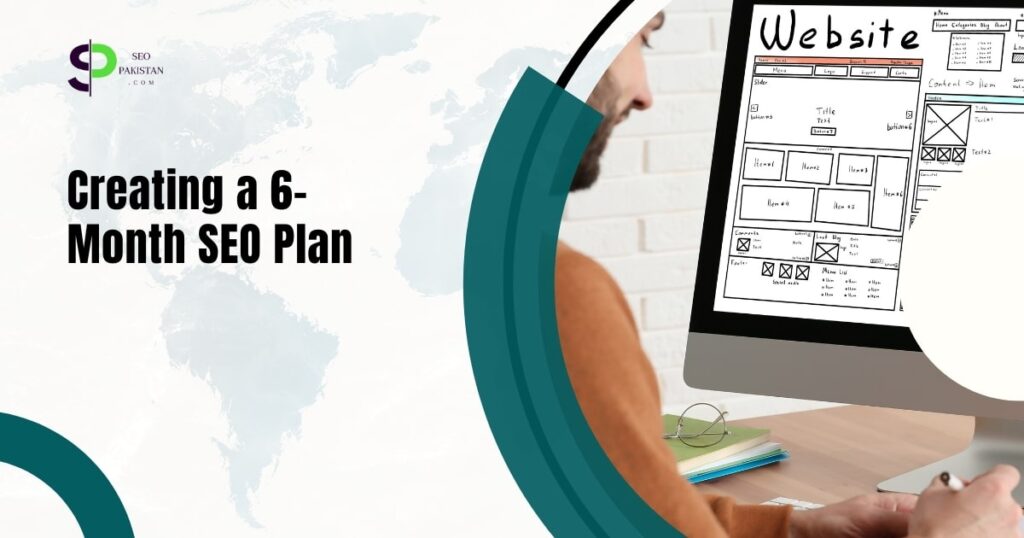
A 6-month SEO plan is a strategic way of enhancing your website’s ranking on the search engine results pages and increasing traffic. This plan should include specific activities and goals for each month to maintain the momentum and flexibility.
- Monthly SEO Plan: Develop a monthly plan to monitor and modify your SEO efforts. This plan should have the activities, time frame and objectives for each month of the plan.
- Monitor Metrics: Create an excel sheet to document your SEO strategy and record the traffic and engagement of your website. This makes it possible to monitor the progress and make decisions based on facts and figures.
- Adjust Accordingly: Depending on the results of your website and its positions in the search engine, make changes to the SEO strategy. Sustaining the efforts is very important in order to achieve the intended goals and objectives.
SEO Monthly Plan
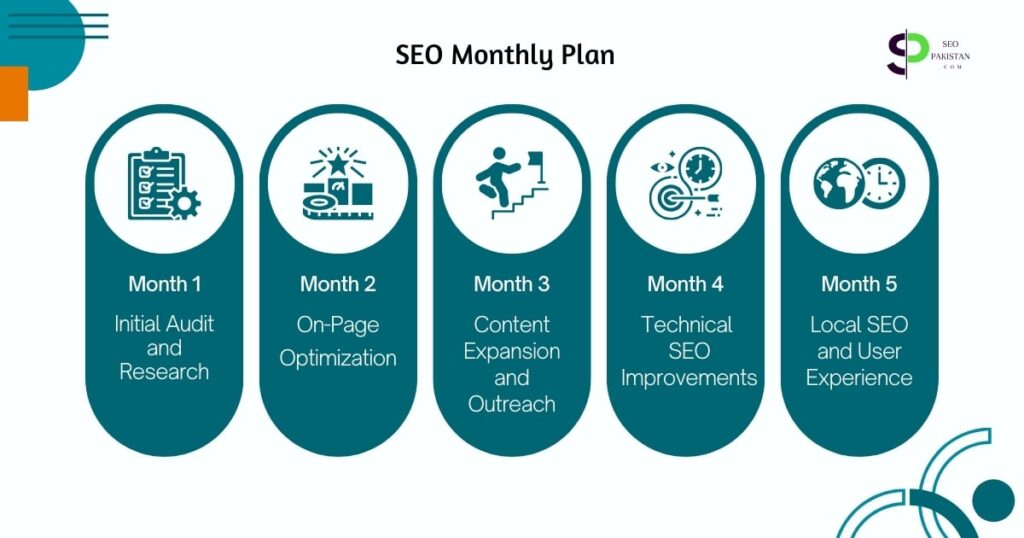
A good SEO monthly plan entails a series of activities aimed at enhancing the website’s visibility and its ranking on the search engine. It is important to set monthly goals and tasks to keep the progress going on all the time.
- Content Planning: Create a monthly content plan to help you with your SEO efforts. This plan should include the topics, formats, and frequency of the content you intend to publish.
- Track Performance: Check the traffic and engagement statistics of your website to evaluate the success of your content strategy. There are tools such as Google Analytics that can help you understand your audience better and what they want.
- Optimize: Always ensure that you are making changes to your content plan depending on the results that you are getting. This entails fine-tuning the keyword targeting, enhancing the quality of the content, and fixing any problems that may occur.
Now, let’s delve into the specifics of each month in the 6-month SEO plan, ensuring a comprehensive and actionable strategy to boost your SEO efforts.
Month 1: Initial Audit and Research
Conduct an SEO Audit
- Technical Audit: Some of the tools that can be used for the technical audit include Screaming Frog, Ahrefs, and Google Search Console. Find out problems like broken links, crawl errors, and duplicate content.
- Content Audit: Analyze your current content to see what is effective and what is not. Determine which content is performing well, which areas are lacking, and where there is potential for improvement.
- Competitor Analysis: Conduct a SWOT analysis of your competitors’ websites to identify their advantages and disadvantages. Find out what keywords they are targeting, their backlink sources, and their content plan.
Keyword Research
- Identify Goals: Define your business goals and how SEO can contribute to their achievement. Identify the metrics that will be used to evaluate the effectiveness of the strategy.
- Keyword Tools: Google Keyword Planner, SEMrush, Ahrefs, and Moz are some of the tools that can be used to find the most popular keywords related to the niche.
- Long-Tail Keywords: Concentrate on keywords that are more niche and have less competition. Such keywords usually have better conversion rates because they attract more targeted traffic.
Content Strategy
- Content Planning: Create a content plan based on the keywords you have identified. Develop a content plan that includes the topics, formats, and the frequency of the posts for the next six months.
- Value Proposition: Make sure that your content is relevant to your audience and solves their problems or answers their questions. The quality of the content is likely to attract and keep the visitors than the quantity of the content.
Month 2: On-Page Optimization
Meta Elements
Title Tags: Include your target keywords in your title tags in the best possible way and ensure they match the reader’s intent. Check they are catchy and provide the reader with the accurate information on what to expect on the given page.
- Meta Descriptions: Make interesting meta descriptions to include your focused keywords. In as much as meta descriptions do not have any impact on the actual rankings, they can impact on click through rates.
- Headings (H1, H2, H3): Headings are important and should be used for the purpose of breaking down content in order to make it easy to read. Ensure that your headings contain your target keywords as that is a sign of relevance to the search engines.
Content Creation
- Keyword Integration: The use of the target keywords must also be placed tactfully into the content. Do not overuse keywords on the website as this will have negative effects on the website search engine ranking more especially when using black hat SEO techniques.
- High-Quality Content: The right information should be researched, well presented, interesting and beneficial to meet the needs of your target group. This makes the top quality content more likely to be shared and linked to thus increasing the search engine ranking.
- Multimedia: You can use pictures, videos, headings, icons, and other types of separation of content in your articles. Multimedia can make the users engage more and can give more opportunities for optimization.
Technical Optimization
- Site Speed: You can achieve this with the help of such services as Google PageSpeed Insights and GTmetrix for your site’s loading speed check. A quick loading of the web site is important in enhancing the usability of the site to the clients, and might highly help with the ranking on the search engines.
- Mobile Optimization: Check that your website is mobile responsive. Do not make it a desktop or a mobile website but rather enhance usage of the two techniques to allow the website to be used on different devices.
- Internal Linking: Organise your web pages internally for more efficient navigation and to help the search engines to comprehend wherein your site one page is equal to another. Internal links can also help users navigate other similar content hence increasing the chances of engagement.
Month 3: Content Expansion and Outreach
Content Creation
- Blog Posts: Blog about topics that fit your determined keywords and ensure you’re writing quality posts that will be beneficial to the readers. This should be done so that one is able to maintain the concentration of the audience in the material being published.
- Guest Posts: Contributing articles for publication on other professional and relevant websites is another effective way of getting backlinks. Guest posting helps you to get high-quality backlinks and bring your website to potential clients, partners, and customers.
- Content Upgrades: Modify your previous content with new and fresh content so that your audience gets new material to read. That helps to update the content, use multimedia and other resources which increases the value of the content and improves the results in the SERP.
Link Building
- Backlink Analysis: Backlinks Ahrefs and Moz should be used to for audity and determination of possible changes in the back link. In this case, one should concentrate on getting more quality backlinks from other relevant and reliable websites.
- Outreach Campaigns: Create marketing efforts for your material and establish cooperation with other websites focused on your subject matter. This can be done by ensuring that you make adjustments basing on the general parameters and characteristics of people with the aim of making your target group small enough to enable a higher success rate.
- Social Media Promotion: Optimize the content and convey it on social media sites to get brand publicity and get backlinks. Social media interaction is also a way how your brand could have a more improved recognition and reputation.
Month 4: Technical SEO Improvements
Site Structure
- URL Structure: See to it that your URLs are neat, meaningful, and contain your keyword list. Do not use parameters in the URLs bringing additional information, but which are not required for accessing the website.
- Breadcrumbs: Employ the use of crumbs and make the designing to be in a way that it helps the search engines in understanding the structure of the site.
- Sitemaps: Submit XML sitemaps to the search engine so that it crawls all the pages you want it to. Its recommended that as you make more additions to your website, you update your sitemaps.
Core Web Vitals
- Largest Contentful Paint (LCP): Make changes to the website to enhance LCP because it comprehensively determines the loading efficiency of the biggest element of the visual content visible on the site. The targeting for the LCP should be set to approximately 2. 5 seconds or less.
- First Input Delay (FID): Improve FID as it mostly calculates the interactivity of your website to the users. Strive for an FID less than 100 milliseconds in your internet system design.
- Cumulative Layout Shift (CLS): Minimizing CLS or the measure of visual stability. The desired CLS score should be less than 0. 1.
Schema Markup
- Structured Data: Use the structured data (Schema Markup) to improve your rich snippets and boost your position in the search engine result page. Tools such as Google’s Structured Data Markup Helper are there to help you.
- Testing and Validation: Use the structured data (Schema Markup) to improve your rich snippets and boost your position in the search engine result page. Tools such as Google’s Structured Data Markup Helper are there to help you.
Month 5: Local SEO and User Experience
Local SEO
- Google My Business: Google provides certain features, namely Rich Results Test and Schema for testing the structured data markup. may use the org’s validator for testing and validation of the structured data implementation you made.
- Local Citations: Make sure you claim your Google My Business listing, diluting it up to the fullest. Check that your business’s NAP is accurate and uniform for all the websites your business is featured on.
- Local Keywords: It is advisable to list your business on the local directories and citation sites to enhance your local searches. It is important to guarantee that NAP information is similar across all the listings.
User Experience (UX)
- Mobile Usability: Make sure your website is built with people first, mobile second and then providing a good desktop experience will follow. To test the mobile friendliness use the Google Mobile-Friendly Test tool.
- Site Navigation: Fix site usability to allow users find what they are looking for very easily on your site. Anticipating and positively receiving visitor behavior has a strong correlation to analyzing and improving the structure allowing your website to have better search engine visibility.
- Accessibility: Guarantee equal access for all people, including those with disabilities, to all the website resources. Use Americans with Disability Act (ADA), and Web CGA (web content accessibility guidelines) to enhance the usability of your websites.
Engagement Metrics
- Bounce Rate: Decrease and pay particular attention to the bounce rate of the website. High bounce rate will lead into the assumption of poor website experience as well as uninteresting content.
- Average Session Duration: Sustain the readers for a longer time by developing quality content that would be of interest to the users and thus deepen their time spent on your site.
- Pages per Session: Find a way to increase page views per visit by using more internal links and using better calls to action that lead the visitors to other pages of your website.
Month 6: Review, Adjust, and Expand
Review and Analysis
- SEO Performance Review: Perform an analysis of the outcomes achieved in the SEO performance done over the last 5 months. The Site Traffic Overview should be evaluated for the organic traffic, keyword position and backlink analysis to know what all strategy benefitted or harmed the website.
- Content Performance: Assess the effectiveness of your contents. Determine which pieces got the most traffic, interactions, and sales/conversions. On the basis of the obtained results, it is possible to adjust and improve further content development and promotion activities.
- Technical SEO Audit: Conduct another technical SEO analysis to check if all the problems that had been diagnosed before are solved, also no new problems are found. Employ Google Search Console, Screaming Frog, and Ahrefs for a more abrasive sweep of the site’s issues.
Adjust and Optimize
- Strategy Adjustment: After reviewing, it is important to modify your SEO approaches in a way that incorporates only the most efficient ones. This may cause one to change his/her focus and concentrate on a different keyword, alter his/her content strategy or even correct his/her approach to link building.
- Content Optimization: Modify the current content using related information. This Spartan update cycle includes updating old information to reflect the most current information, the integration of relevant keywords, and the addition of new Multimedia Elements to the page to improve usability by the page’s target audience.
- Technical Improvements: Solve any of the remaining technical problems and fine tune your website for quick loading and high accessibility.
Expand SEO Efforts
New Keywords: Always do a new keyword search to uncover new keywords. Concentrating on the appearance of new trends and topics connected with the sphere of your activity to be ahead of the competitors.
- Content Expansion: Build more content where the keyword research is pointing to, and using the performance indicators obtained from SEM. It is essential to form a variety of content materials like videos , infographics or any other ways of engaging a reader.
- Advanced Link Building: Discussed on more sophisticated methods of link building like using the broken link and the skyscraper method, as well as using advanced digital PR to get quality links. Back linking is a way of improving the quality and authority of a site and is consists of the links on your site to other sites.
Ongoing SEO Maintenance

SEO is an ongoing process that requires continuous monitoring, adjustment, and improvement. Here’s how to maintain your SEO efforts beyond the initial 6-month plan.
Regular Monitoring
- Performance Tracking: Seo is not a one-time activity therefore ensure you are monitoring your website performance through google analytics, Google search console, and other SEO tool. Track organic traffic, bounce rate, conversion rate, and preferred keywords’ ranking.
- Competitor Analysis: New-Perform a competitor analysis at least every quarter to assess the competitor’s strategies in the market and be on the lookout for ways to dominate them. Services as SEMrush and Ahrefs are useful when it comes to identifying competitors’ keywords, their backlinks, and content plan.
- Technical Health: It helps to conduct technical checks every now and then, to prevent such a situation when your site maps have broken links or contain crawl errors, and is not immune to possessing duplicate content. It is established to resolve any new emerging issues to ensure the sites are healthy.
Content Refresh and Expansion
- Update Content: Make sure to edit new and old published material, so it represents the most up-to-date and high-quality information. This can be the extension of the existing records, replacement of the obsolete data and the establishment for the new keywords.
- Content Creation: Update regularly in order to attract the attention of the audience as well as the frequent visitors. Stick on your content calendar but be able to morph to accommodate new trends and issues as they come.
- User Feedback: Make surveys that aim at identifying the needs and preferences of the users. You should incorporate it into Content and User Experience enhancement on a regular basis.
Link Building and Outreach
- Ongoing Outreach: Continue with the out-reach to promote relations with other websites in your category. Still, guest posting, collaborations, and worked on influencer can assist in obtaining high-quality backlinks.
- Link Profile Monitoring: It helps to check your back links on a regular basis to know whether they are in a healthy state. Reject any link which is related to spam or has no relevance to the site and instead try to obtain good backlinks.
- Social Media and PR: Optimize your articles and web pages for use in social media networks and digital public relations to increase the number of your backlinks. Interacting with your audience on the social media platforms also helps increase awareness of your brand and its credibility.
Conclusion
Developing a great SEO strategy takes vision, time, and persistence and must be approached on a war-mission basis. Adopting this process, one can design a professional SEO strategy for the next 6 months resulting in organic traffic, better ranking positions, and increased online visibility.
As you know, SEO is more like a continuous process where one often has to monitor, update, and fine-tune the strategies applied. Check with the sources regularly to see what trends or new changes to the algorithms are emerging on the market, so that changes can be made to the system where necessary for the website to perform optimally.
Through keyword research, on-site optimization, content development, technical SEO, off-site optimization and monitoring of SEO results you can lay the groundwork for long term and successful SEO. These strategies should be employed systematically over the period of six months, this will ensure the website’s content is set to continue growing and gaining more traffic in the coming months.

